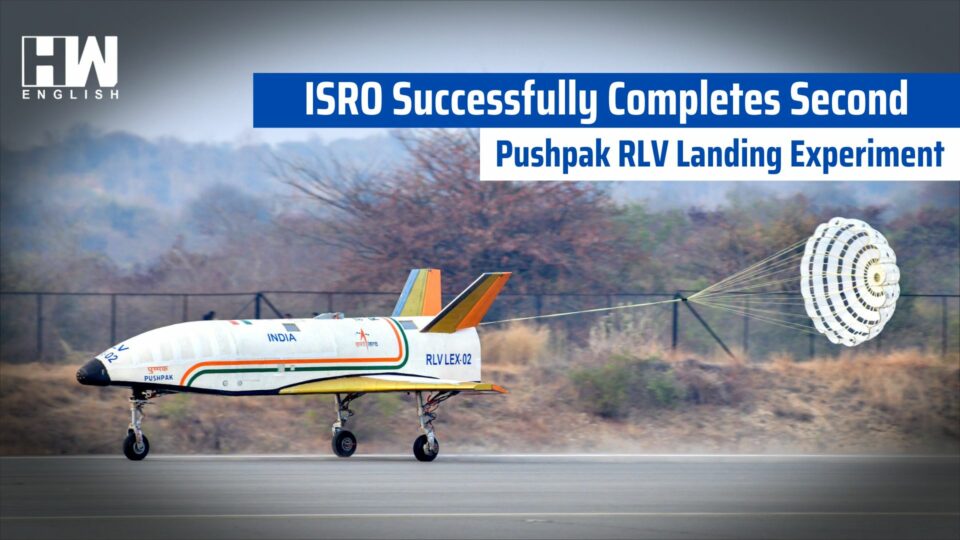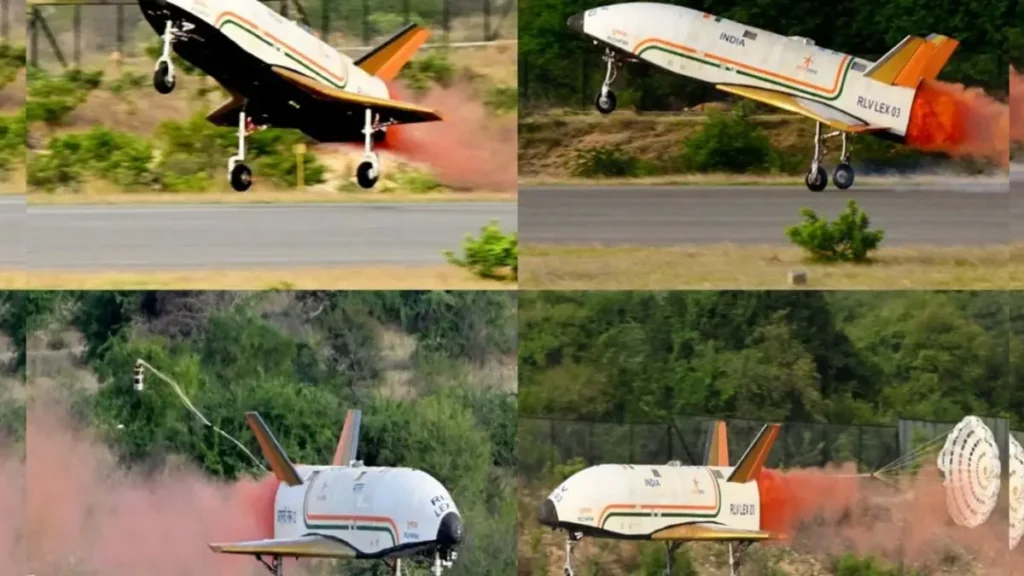Pushpak: ISRO’s Reusable Launch Vehicle: 3rd Success
Reusable Launch Vehicle
With the successful completion of the third landing experiment for the Reusable Launch Vehicle (RLV) known as Reusable Launch Vehicle ,” the Indian Space Research Organisation (ISRO) has once again shown its competence in space technology. This accomplishment, which took place on June 23, 2024, at the Aeronautical Test Range (ATR) in Chitradurga, Karnataka, is a major step in the direction of the creation of an orbital reusable vehicle. RLV LEX-03 demonstrated ISRO’s enhanced autonomous capabilities and the agency’s dedication to developing reusable space technology.

An Overview of the Mission of Reusable Launch Vehicle Pushpak
Early in the morning, at 07:30 IST, the RLV LEX-03 mission—also known as “Pushpak”—was carried out. The goal of this mission, the third in a series of landing experiments, is to confirm the RLV’s ability to land itself autonomously in progressively difficult situations. This mission’s success opens the door for ISRO to move from landing experiments to orbital re-entry missions, ushering in a new phase of Indian space exploration activities.
Goals and Successes of the Pushpak
For the RLV LEX-03 mission, simulating the approach, landing interface, and high-speed landing conditions that a vehicle might encounter upon re-entering space was the main goal. This achievement shows that ISRO can get and refine the critical technologies needed to construct a Reusable Launch Vehicle that is completely functional.
The successful validation of an advanced navigation algorithm was a major mission accomplishment. In order to ensure that future orbital missions may be carried out with the highest level of safety and precision, this method is essential for handling longitudinal and lateral plane error corrections during re-entry missions.
India’s Proud

Technical Details of the Reusable Launch Vehicle -03 Mission
Defensive Landing
The RLV LEX-03 mission expanded on the achievements of the RLV LEX-01 and LEX-02 missions. Atop a 4.5-kilometer Chinook helicopter operated by the Indian Air Force, “Pushpak” was dropped during this mission. Despite the difficult circumstances, the car autonomously performed a number of intricate maneuvers from this height to approach and land precisely on the runway centerline.
Elevated-Speed Drop of the Pushpak
The low lift-to-drag ratio of Pushpak ‘s aerodynamic configuration required a landing speed greater than 320 km/h. In contrast, fighter aircraft land at 280 km/h, and commercial aircraft generally land at about 260 km/h. This fast landing showcased the vehicle’s strength and the efficiency of its control and design elements.
Post-Landing Deceleration
Pushpak decelerated to about 100 km/h after touchdown by using a brake parachute. Afterwards, the landing gear brakes were used to slow down. In addition to demonstrating the car’s sophisticated braking and ground handling skills, this sequential deceleration technique ensured a safe and controlled ground roll.
Multisensor Fusion
To attain accurate navigation and control during the landing phase, the RLV LEX-03 mission made use of multisensor fusion technology. Radar altimeter, flush air data system, pseudolite system, inertial sensor, and NavIC were among the onboard systems. Pushpak’s trajectory was precise and steady the whole voyage thanks to this combination of sensors.
Recycling and Creativity
The reuse of the winged body and flight components from the LEX-02 mission was one of the most impressive features of the RLV LEX-03 mission. Reusable flight systems are essential for cutting costs and improving the effectiveness of space missions, and this showed that ISRO can develop and run them.
ISRO’s inventiveness and technological know-how are demonstrated by the success of this reusable technique.
Working Together
With the Vikram Sarabhai Space Centre (VSSC) serving as the project leader, several other ISRO centers participated in the joint RLV LEX-03 mission. ISTRAC (ISRO Telemetry, Tracking and Command Network), the Satish Dhawan Space Centre (SDSC-SHAR), and the Space Applications Centre (SAC) were among the main contributors. Aerial Delivery Research and Development Establishment (ADRDE), Aeronautical Development Establishment (ADE), Indian Air Force (IAF), and the Regional Centre for Military Airworthiness (RCMA) under the Centre for Military Airworthiness and Certification (CEMILAC) all provided substantial support for the mission.
The mission also profited from partnerships with the Indian Oil Corporation of India, the Airport Authority of India, the Indian Institute of Technology, Kanpur, National Aerospace Laboratories (NAL), and Indian aerospace industrial partners.
This wide-ranging network of collaborations demonstrates the comprehensive strategy adopted by ISRO to enhance its space capabilities.
Leadership and Acknowledgements
The entire ISRO crew deserves special recognition for their committed work on the RLV LEX-03 mission. The team received praise from ISRO Chairman S.. Somanath for their continuous devotion and determination to maintaining a successful record in these challenging missions. For this mission, J.. Muthupandian was the mission director, and B.. Karthik was the vehicle director. The mission’s goals were accomplished in large part thanks to their experience and leadership.
It is clear from S.. Unnikrishnan Nair, Director of VSSC, that ISRO is more confident in the vital technologies required for the the next orbital re-entry missions because of this continuous success. ISRO has proven its capacity and preparedness to move forward with its reusable launch vehicle program with the successful completion of the RLV LEX-03 mission in spite of difficult circumstances.
Conclusion
An important step has been taken in ISRO’s development of an orbital reusable vehicle with the successful completion of the RLV LEX-03 mission. The success of the mission highlights ISRO’s technological expertise, spirit of innovation, and cooperative methodology.
The technology and lessons learnt during the Reusable Launch Vehicle -03 mission will surely be important in defining space exploration going forward, especially as ISRO presses on with its RLV-ORV (Orbital Reusable Vehicle) program.
India is positioned to play a major role in the international space community as ISRO continues to push the boundaries of space technology with each successful mission.
What is the use of ISRO Reusable Launch Vehicle Pushpak?
In order to maintain a steady and accurate ground roll along the runway, Pushpak used its rudder and nose wheel steering system on its own. In a statement, ISRO claims that the experiment has validated its proficiency in obtaining the most important technology needed for the creation of a reusable launch vehicle.
What is the launch vehicle, Pushpak?
The autonomous landing capability of the RLV in more difficult release conditions and strong wind conditions was shown by the RLV LEX-03 mission. At four and a half kilometers above the ground, the Indian Air Force’s Pushpak was launched from a Chinook chopper.
What is the reusable launch vehicle of India?
Pushpak, ISRO’s reusable launch vehicle, clears test





Hi i think that i saw you visited my web site thus i came to Return the favore Im attempting to find things to enhance my siteI suppose its ok to use a few of your ideas
Absolutely, feel free to use any ideas from my site to enhance your own! Collaboration and sharing knowledge can greatly benefit both of our sites. If you have any specific questions or need further assistance, just let me know. I’m happy to help!
Pingback: Chandrayaan-4: India's Next Lunar Mission
Thank you for your kind words! I’m glad you found the content both educational and entertaining. If there’s a specific topic you’re interested in or if you have any questions, feel free to let me know!
Pingback: What Microwave photonic radar?Next-Gen Sensing Tech 24
Thank you for your kind words! I’m glad you found the information useful. If you have any more questions or need further assistance, feel free to ask. Best of luck to you as well!
Pingback: Is Ram Setu Real or Not? Ancient Mystery Explored 24
Thank you for your kind words! I’m glad you found the information useful. If you have any more questions or need further assistance, feel free to ask. Best of luck to you as well!
Pingback: What is Bharatiya Antariksh Station : India's Space Dream 24
Thank you for your kind words! I’m glad you found the information useful. If you have any more questions or need further assistance, feel free to ask. Best of luck to you as well!